Massive heat wave and a supercell thunderstorm caused deadly, baseball-sized hailstones to rain down on Spain

A heat wave fueled by climate change helped create deadly, record-breaking hail in Spain, a new study finds.
The baseball-sized hail hit northeastern Spain in August 2022, injuring 67 people and killing a 20 month old girl. Videos of the storm show balls of ice up to 4.7 inches (12 centimeters) wide dropping from the sky, smashing car windows and damaging property.
To better understand the event, researchers ran computer simulations to predict the impact of the hailstorm under different conditions. They found that extra atmospheric energy and moisture from a marine heat wave in the Mediterranean Sea intensified the hailstorm and helped create the massive hailstones, according to the study, published March 22 in the journal Geophysical Research Letters.
The hailstones were the largest ever recorded in the country, and the death was the first direct hail fatality in Europe in more than 25 years. Study co-author Carlos Calvo-Sancho, a doctoral candidate who studies severe weather at the University of Valladolid in Spain, told Live Science that he thinks hail is now the main severe-weather threat to Europe.
Although the 4.7-inch-wide hailstones broke records in Spain, researchers have documented even larger examples elsewhere. For example, Italy recorded a hailstone diameter of 7.5 inches (19 cm) in 2023, while the U.S. record is an 8-inch-wide (20.32 cm) hailstone that fell in South Dakota in 2010.
Related: AI-powered 'digital twin' of Earth could make weather predictions at super speeds
Hail forms from frozen raindrops that are carried high into cold parts of the atmosphere on updrafts during thunderstorms, according to the National Oceanic and Atmospheric Administration's National Severe Storms Laboratory. The Spanish hail event was part of a supercell thunderstorm, which has a deep and persistent rotating updraft called a mesocyclone, according to the National Weather Service. This gives the hail more time to accumulate new water droplets and get bigger before falling back to Earth.

To simulate the hailstorm, the researchers looked at more than 150 large-hail reports collected between 1940 and 2022. They found that removing the marine heat wave as a factor meant the giant hail was less likely to occur, according to the study.
A marine heat wave involves a persistent anomaly of higher sea surface temperatures for at least five days. In this case, the Western Mediterranean Sea was 5.89 degrees Fahrenheit (3.27 degrees Celsius) hotter than normal for six weeks during the summer of 2022, when the hail event occurred, according to the study.
RELATED STORIES
—Atlantic's hurricane alley is so hot from El Niño, it could send 2024's storm season into overdrive
—We may need a new 'Category 6' hurricane level for winds over 192 mph, study suggests
With climate change increasing sea surface temperatures, the team also examined what role humans may have had in the hail event. To do so, they compared the conditions with those of a preindustrial climate.
"When we resimulated the event, we saw that the hail size is lower [in preindustrial conditions] than in present conditions," Calvo-Sancho said.
This isn't the first study to link climate change to the size of hailstones and the severity of hailstorms. A 2017 study published in the journal Nature Climate Change is one of several examples that predict more frequent larger-hail events are coming.

